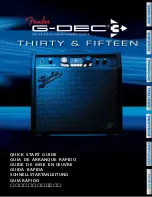
4-6
Front Panel
INPUT OVLD
The OVLD led in this section indicates an INPUT overload. This occurs
for voltage inputs greater than 1.4Vpk (unless removed by AC coupling)
or current inputs greater than 10 µA DC or 1.4 µA AC (1M
Ω
gain) or
100 nA DC or 14 nA AC (100M
Ω
gain). Reduce the input signal level.
[Couple]
This key selects the input coupling. The signal input can be either AC or
DC coupled. The current input is coupled after the current to voltage con-
version. The current input itself is always DC coupled (1 k
Ω
to virtual
ground).
The AC coupling high pass filter passes signals above 160 mHz and
attenuates signals at lower frequencies. AC coupling should be used at
frequencies above 160 mHz whenever possible. At lower frequencies,
DC coupling is required. AC coupling results in gain and phase errors at
low frequencies.
Remember, the Reference Input is AC coupled when a sine refer-
ence is used. This also results in phase errors at low frequencies.
[Ground]
This key chooses the shield grounding configuration. The shields of the
input connectors (A and B) are not connected directly to the lock-in chas-
sis ground. In Float mode, the shields are connected by 10 k
Ω
to the
chassis ground. In Ground mode, the shields are connected by 10
Ω
to
ground. Typically, the shields should be grounded if the signal source is
floating and floating if the signal source is grounded. Do not exceed 1 V
on the shields.
[Notch]
This key selects no line notch filters, the line frequency or twice line fre-
quency notch, or both filters. The line notch filters are pre-tuned to the
line frequency (50 or 60 Hz) and twice the line frequency (100 or 120
Hz).
These filters have an attenuation depth of at least 30 dB. These filters
have a finite range of attenuation, generally 10 Hz or so. If the reference
frequency is 70 Hz, do not use the 60 Hz notch filter! The signal will be
attenuated and the phase shifted. See the SR830 Basics section for a
discussion of when these filters improve a measurement.
Summary of Contents for SR830
Page 5: ...1 4...
Page 11: ...SR830 DSP Lock In Amplifier 1 10...
Page 13: ...2 2 Getting Started...
Page 17: ...2 6 The Basic Lock in...
Page 23: ...2 12 Outputs Offsets and Expands...
Page 25: ...2 14 Storing and Recalling Setups...
Page 31: ...3 4 SR830 Basics...
Page 33: ...3 6 SR830 Basics...
Page 37: ...3 10 SR830 Basics...
Page 53: ...3 26 SR830 Basics...
Page 74: ......
Page 83: ...4 30 Rear Panel...
Page 107: ...5 24 Remote Programming...
Page 113: ...5 30 Remote Programming...
Page 117: ...5 34 Remote Programming...
Page 121: ...6 4 Performance Tests...
Page 123: ...6 6 Performance Tests...
Page 125: ...6 8 Performance Tests...
Page 129: ...6 12 Performance Tests...
Page 131: ...6 14 Performance Tests...
Page 133: ...6 16 Performance Tests...
Page 139: ...6 22 Performance Tests...
Page 145: ...7 2 Circuit Description...
















































